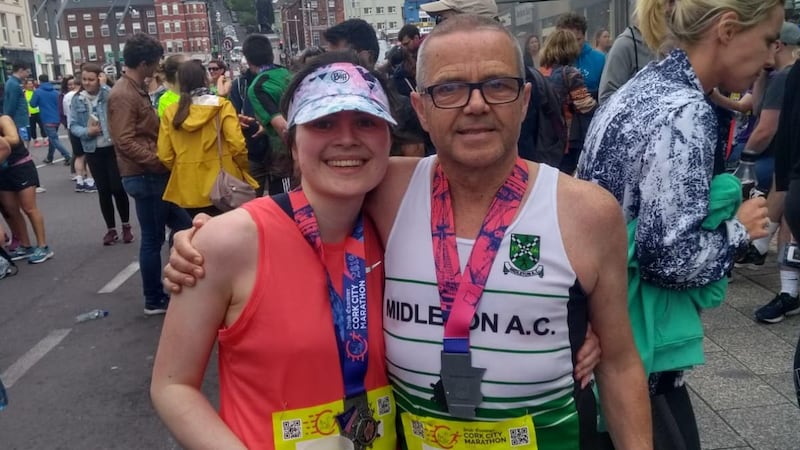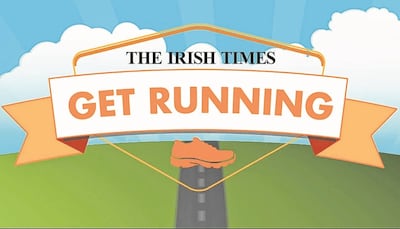Last May, I wrote a piece for this paper on the week before running the Cork City Marathon, which was on the eve of my 60th birthday.
The article was relatively upbeat. I had been diagnosed with lymphatic cancer some three years ago and running had kept me both fit and sane. I concluded optimistically by saying I would run the race alongside my daughter Sinéad, both of us with missions in mind. She was chasing a PB and while I planned to behave like the two-faced Roman god Janus, reflecting on my 50s while looking forward to my swinging 60s.
Sometimes you get what you wish for.
Other times, you get the opposite.
I spent two days as a wishful-thinking Janus before morphing into a wing-melting Icarus. Underestimating my mortality, I had flown far too near the sun.
While having breakfast in Sneem Hotel, Gerri, my wife was giving me rather more facial attention than usual. It was one of those “are you alright” stares, which after 33 years of marriage is easily shrugged off with a reciprocal: “I’m fine.”
“Your face has gone all funny and you’ve egg on your cheek!” I dabbed the right side of my face, which is usually my drool side, with my napkin. She pointed to the left-hand side and then at my left hand as another piece of black pudding fell from my fork. My daughter then joined us: “Dad, I think you are having a stroke!”
That was it. Gerri dialled 999.
As we waited for the ambulance to arrive I remained in the world of total denial. I had felt nothing. While the world around me entered emergency mode I sat in the hotel lobby trying to prove that this was all some false alarm. I could, think, talk and walk. But in true defiance of my denial, my brain was busy fighting a clot.
From Kerry Hospital I was transferred to the neurology unit in Cork University Hospital under the care of Prof Aisling Ryan and her team. There followed a week of probing and scanning. An MRI revealed that this had been my second stroke, as I had had another previously undiagnosed. I was told how lucky I was to be left with no deficits or nasty post-stroke symptoms before being discharged with few conditions.
I seemed to tick all the stroke preventative boxes. I do not smoke, I drink moderately, my diet is that good “more white meat than red and five-a-day combo”. I am healthy (except for the lymphoma!) and fit, so apart from daily blood pressure, cholesterol and aspirin tablets, I was sent back into the world of normalcy with the aim of simply doing the things I always did before the stroke. Running, doctor?
Extreme fatigue
Prof Ryan and her team did not make a direct correlation between my marathon run on a Sunday and suffering a stroke three days later. She advised me to run when my body felt like it and post-stroke I would symptomatically experience extreme fatigue so my return to running would have to be gradual. But yes, Peter, you can run!
For the first week or two I walked a few miles each day. Whilst this was fine it never felt like proper exercise. Walking does not take me anyway near the running Zen. I longed to pick up the pace and hear the homely pitter patter of my running stride. I have written previously about the positivity running brings to my life and I firmly believe that it has helped to keep me treatment-free with my Non-Hodgkins Lymphoma. But the suddenness of the stroke genuinely terrified me and the idea of going to the running track seemed less a return to my normalcy than a dance under the sword of Damocles.

To me, running has always been my default button to rationalise. A problem-solving catharsis. Now I was fearful that it zoomed in as the problem to be solved. Running was now my dilemma. Even though I craved the serotonin rush, I was reluctant to pull the pin on the timebomb running now presented.
But four weeks after my stroke I felt it was time to take on this psychological battle. It was time to run. I went up to the UCC track on the Mardyke and decided to do a walk-run session. I planned eight reps of one minute walk/two minute run. As I began to run I echoed the Armstrong mantra: “One small step for this man.” But it was, for me, a massive leap into my future. As I rounded the bend for the first time I looked at the straight ahead of me and I knew that once I made it to the next bend my first two minutes were done. I was back.
My return to running has been constant since and I am now up to four or five runs of 30-40 minutes per week with no emphasis on either speed or distance. The fear of running causing another stroke has been pushed to the back of my mind, also due to the wonders of technology. This week I was fitted with a loop implant recorder in my chest. The implant is the size of a stick of chewing gum and records the rhythm of my heart. At night-time it feeds this record into a small gadget I keep plugged in on my bedside locker. This information is then forwarded automatically to the Cathlab in Cork University Hospital who will inform me if there is any irregularity or abnormal heart rhythm.
As I run I have become more the stroke survivor and less the victim. I feel grateful to be able to tie my running shoes each day without the impact of any stroke side-effect. I am lucky.
I have won the psychological battle, with the sword returned to Damocles unsheathed, while my loop ticks on silently.

Sign up for one of The Irish Times' Get Running programmes (it is free!).
First, pick the eight-week programme that suits you.
- Beginner Course: A course to take you from inactivity to running for 30 minutes.
- Stay On Track: For those who can squeeze in a run a few times a week.
- 10km Course: Designed for those who want to move up to the 10km mark.
Best of luck!
















